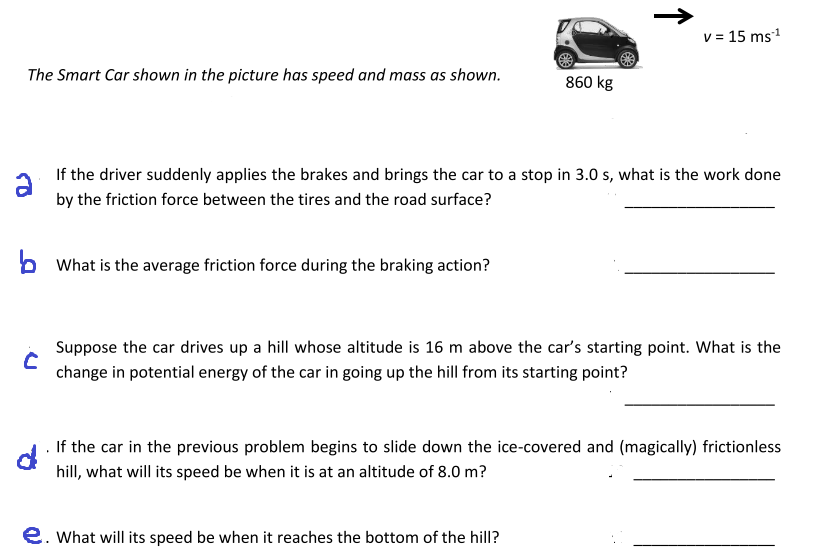v = 15 ms The Smart Car shown in the picture has speed and mass as shown. 860 kg a If the driver suddenly applies the brakes and brings the car to a stop in 3.0 s, what is the work done a by the friction force between the tires and the road surface? b What is the average friction force during the braking action? Suppose the car drives up a hill whose altitude is 16 m above the car's starting point. What is the change in potential energy of the car in going up the hill from its starting point? If the car in the previous problem begins to slide down the ice-covered and (magically) frictionless hill, what will its speed be when it is at an altitude of 8.0 m? e. What will its speed be when it reaches the bottom of the hill?
v = 15 ms The Smart Car shown in the picture has speed and mass as shown. 860 kg a If the driver suddenly applies the brakes and brings the car to a stop in 3.0 s, what is the work done a by the friction force between the tires and the road surface? b What is the average friction force during the braking action? Suppose the car drives up a hill whose altitude is 16 m above the car's starting point. What is the change in potential energy of the car in going up the hill from its starting point? If the car in the previous problem begins to slide down the ice-covered and (magically) frictionless hill, what will its speed be when it is at an altitude of 8.0 m? e. What will its speed be when it reaches the bottom of the hill?
University Physics Volume 1
18th Edition
ISBN:9781938168277
Author:William Moebs, Samuel J. Ling, Jeff Sanny
Publisher:William Moebs, Samuel J. Ling, Jeff Sanny
Chapter7: Work And Kinetic Energy
Section: Chapter Questions
Problem 26P: Suppose a car travels 108 km at a speed of 30.0 m/s, and uses 2.0 gal of gasoline. Only 30 of the...
Related questions
Question

Transcribed Image Text:v = 15 ms1
The Smart Car shown in the picture has speed and mass as shown.
860 kg
If the driver suddenly applies the brakes and brings the car to a stop in 3.0 s, what is the work done
by the friction force between the tires and the road surface?
What is the average friction force during the braking action?
Suppose the car drives up a hill whose altitude is 16 m above the car's starting point. What is the
change in potential energy of the car in going up the hill from its starting point?
If the car in the previous problem begins to slide down the ice-covered and (magically) frictionless
hill, what will its speed be when it is at an altitude of 8.0 m?
e. What will its speed be when it reaches the bottom of the hill?
Expert Solution
This question has been solved!
Explore an expertly crafted, step-by-step solution for a thorough understanding of key concepts.
This is a popular solution!
Trending now
This is a popular solution!
Step by step
Solved in 2 steps

Knowledge Booster
Learn more about
Need a deep-dive on the concept behind this application? Look no further. Learn more about this topic, physics and related others by exploring similar questions and additional content below.Recommended textbooks for you

University Physics Volume 1
Physics
ISBN:
9781938168277
Author:
William Moebs, Samuel J. Ling, Jeff Sanny
Publisher:
OpenStax - Rice University

College Physics
Physics
ISBN:
9781285737027
Author:
Raymond A. Serway, Chris Vuille
Publisher:
Cengage Learning

College Physics
Physics
ISBN:
9781938168000
Author:
Paul Peter Urone, Roger Hinrichs
Publisher:
OpenStax College

University Physics Volume 1
Physics
ISBN:
9781938168277
Author:
William Moebs, Samuel J. Ling, Jeff Sanny
Publisher:
OpenStax - Rice University

College Physics
Physics
ISBN:
9781285737027
Author:
Raymond A. Serway, Chris Vuille
Publisher:
Cengage Learning

College Physics
Physics
ISBN:
9781938168000
Author:
Paul Peter Urone, Roger Hinrichs
Publisher:
OpenStax College

Glencoe Physics: Principles and Problems, Student…
Physics
ISBN:
9780078807213
Author:
Paul W. Zitzewitz
Publisher:
Glencoe/McGraw-Hill


Principles of Physics: A Calculus-Based Text
Physics
ISBN:
9781133104261
Author:
Raymond A. Serway, John W. Jewett
Publisher:
Cengage Learning